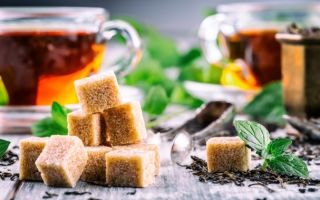Content
- 1 What makes cane sugar different from regular sugar?
- 2 Which sugar is sweeter: cane or beet sugar
- 3 Types of cane sugar
- 4 The composition and calorie content of cane sugar
- 5 The benefits of brown cane sugar
- 6 Is there any benefit in refined cane sugar
- 7 Features of the use of sugar
- 8 Cane sugar scrub for skin beauty
- 9 How to tell real cane sugar from fake
- 10 The harm of cane sugar and contraindications
- 11 Conclusion
Natural cane sugar is included in the list of dietary carbohydrate sources. It is obtained from sugar cane for a long time in India, from where it spread throughout the globe thanks to merchants and conquerors. In Russia, the benefits and harms of cane sugar have not been studied for a long time. Now it is gaining more and more popularity among adherents of proper nutrition. It is believed to have much more beneficial properties and much less harm than its beetroot counterpart.
How cane sugar differs from regular sugar
Unlike beetroot, cane cane contains 20 times more potassium, 10 times more iron and as much as 85 times more calcium. The composition also contains the magnesium necessary for the body, which is absent in beetroot at all, and the amount of copper is practically the same as in oysters!
Cane sugar contains B vitamins, which improve metabolism and ensure the normal functioning of the whole body.
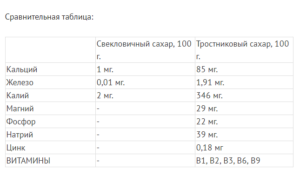
The difference is tangible even in culinary terms. Cane sugar has the taste and color of caramel, which is appreciated by real gourmets. Dishes acquire an exquisite and delicate caramel flavor and aroma. They especially enhance the taste of drinks and sauces.
The brown color is due to the presence of molasses (black syrup), which is a source of useful trace elements and even proteins. The darker the color, the more molasses it contains and the more useful the properties. For this reason, black cane sugar is especially popular.
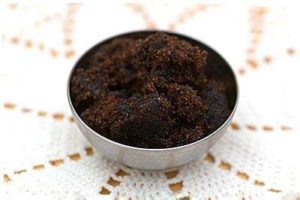
Both varieties have almost the same energy value (about 400 kcal), however, beetroot loses to cane, which supplies unique substances that are beneficial. The latter, among other things, refers to slow carbohydrates and does not cause significant harm: it is impossible to replenish or get an overdose of glucose in this case.
Which sugar is sweeter: cane or beet sugar
Cane sugar is believed to be sweeter than beet sugar. However, according to GOST, any sweetener produced in factories consists almost entirely of sucrose, which determines the degree of sweetness.
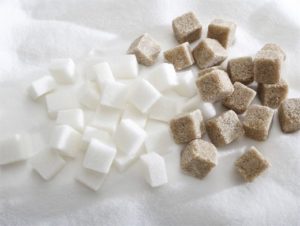
Apart from the differences in the content of useful components, the composition of both options is the same. The only difference is in the area of their contact with the taste buds. The crystals of cane sweetener are larger in size, which makes it seem sweeter when taken by mouth. But if dissolved in tea or coffee, then the degree of sweetness will be the same as that of ordinary.
Types of cane sugar
In order to choose cane sugar, you need to know the manufacturing process and the differences in the varieties of this carbohydrate source.
According to the manufacturing principle, they are distinguished:
- Refined (white), that is, it has passed the refining procedure: turning into a syrup, filtration, evaporation and drying.
- Unrefined (brown), that is, practically untreated. It is this type that is most often eaten, because the benefits of unrefined cane sugar are explained by the high content of molasses.
Types of brown sugar:
- Muscovado (Muscovado sugar): has a distinct caramel aroma, honey color and slightly moist sticky crystals of medium size, grown in South America and Mauritius.
- Demerara (Demerara sugar): has hard and sticky crystals of golden hues, it grows in South America and is called the Demerara River, since it began to enter the world market from this area.
- Hblack reed (Soft molasses sugar): contains a large amount of molasses and is very dark in color, has the softest and stickiest crystals, and has a rich taste and aroma of cane.
- Turbinado (Turbinado sugar): Processed with a turbine or centrifuge with water and steam to remove impurities and impurities, has dry, large honey to brown crystals and comes mainly from Hawaii.
- Gur: a special kind, which came from India, is a condensed sugarcane juice, which is squeezed out very slowly and retains its useful properties; in color and consistency, it is similar to soft sherbet.
The composition and calorie content of cane sugar
This type of sugar is an excellent calorifier that won't do much harm to your figure. It contains a significant proportion of trace elements and vitamins with valuable properties. In terms of the content of calcium, magnesium, iron, phosphorus and zinc, it surpasses all similar products, so its benefits can hardly be overestimated. For example, in Western countries, vegetarians use dark sugar as a source of iron and magnesium.
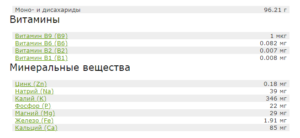
The energy value:
- proteins ≈ 0.70 g;
- fats - 0 g;
- carbohydrates ≈ 96 g.
Cane sugar contains slightly fewer calories than regular sugar. The calorie content of one hundred grams is 377–398 kcal.
The benefits of brown cane sugar
The dark cane sweetener supplies carbohydrates that are necessary for the synthesis of special hormones, without which most biological processes cannot function normally. In addition to carbohydrates, it provides the body with B vitamins and a host of important micronutrients that provide tremendous health benefits. In total, it contains about two hundred useful substances, due to the properties of which:
- the brain and nervous system function better;
- blood pressure is normalized;
- bones and joints are strengthened;
- improves and regulates metabolism;
- strength and energy appear;
- slags are removed from fabrics;
- digestion improves;
- the work of the liver and spleen is stimulated;
- the work of the cardiovascular system is stabilized.
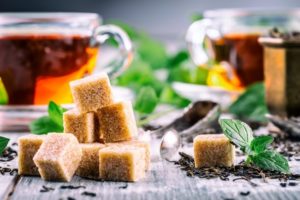
Among other things, cane sugar in moderation can also be consumed with weight loss, since the useful components that make up the composition are transformed into energy without turning into fatty compounds. Thus, it can be included in the menu of any diet and sports nutrition. Another plus: it does not cause allergic reactions, so cane sugar will definitely not harm even children. But if the child has any diseases, you must first consult a doctor.
Is there any benefit in refined cane sugar
Many people think that refined sugar is obtained using chemistry, but this is not the case. In the process, only water and special raw materials are used.
In terms of calorie content and sucrose content, refined and unrefined cane sugar practically do not differ from each other (maximum by 10 kcal). The main difference is only in the content of useful elements, which are much less in the refined version due to processing. However, a small part of them remain.
Features of the use of sugar
If you completely abandon the use of sweets, blood circulation will be disrupted, and with it the normal functioning of most body systems. This means that sugar must be included in the diet. It is only important to choose the right type of cane sweetener and observe the dosage.
Daily intake
Adequate dosage per day is approximately 45 grams. In this case, no diet will be broken. Up to six tablespoons of this substance can be consumed per day, so you won't have to give up sweets.
Is cane sugar possible for diabetes
In milder stages of diabetes, it is allowed to consume a small amount of sweets, which is prescribed by a doctor. Basically, this is about 5% of the daily carbohydrate intake. It is necessary to be careful about the amount consumed and take into account the composition when dosing drugs that lower blood sugar levels. At the same time, you can include only high-quality varieties in the diet and be able to distinguish them from harmful fakes.
With diabetes of the first and second types, it is better to stop using this product, since the glycemic index of cane sugar is quite high and is 55 units. This increases glucose levels and the proportion of carbohydrates in the body. In such cases, it is better to give preference to sweeteners.
Cane sugar for pancreatitis
If inflammatory processes occur in the digestive organs, you need to be careful about the use of any sweets and follow a moderate dosage. With pancreatitis, doctors recommend adding only one teaspoon of cane sugar to drinks, but it is better to give up the treats altogether during the illness.
Cane sugar during pregnancy and breastfeeding
During pregnancy, it is recommended to replace regular sugar with cane sugar, as it contains the elements necessary for mother and child and is well absorbed. In addition, it can improve lactation and milk taste, help cope with insomnia, and promote quick recovery from childbirth and the production of the hormone of happiness. However, the calorie content here is not lower than that of the usual one, which means that the consumption should be reduced to three tablespoons a day, because pregnant and lactating women are prone to obesity.
Cane sugar scrub for skin beauty
Brown sugar is the best option for making scrubs. It has a delicate effect on the skin surface, and a pleasant caramel aroma can relax.
Scrubs with the addition of this component have a lot of useful properties.
- They normalize the fat metabolism of the skin.
- Eliminate flaking.
- Moisturize.
- Cleanses pores.
- Fight cellulite.
- Rejuvenates and smoothes.
- Remove toxins.
- Evens out the complexion.
- Remove dead cells.
- Used for massage.
- Give shine.
- Suitable for use before shaving to prevent ingrown hairs.
- They make the skin softer.
- Absorbs excess fat.
- Maintains the natural balance of the skin.
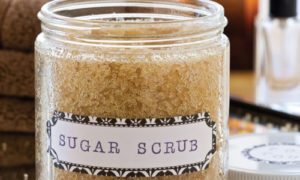
In addition to the described component, the scrub consists of a base (honey, butter, cream) and a couple of drops of essential oil (optional), which give the product additional useful properties.
Cane Sugar Scrub Recipes
- Mix 3 tbsp. l. olive oil, 1 tbsp. l. vanilla extract and vitamin E, 2 tsp. natural honey and 2 tbsp. l. cane sweetener.
- Mix in 2 tbsp. l. white and brown sugar, 1 tbsp. l. sea salt, 1/3 cup baby oil.
- Mix cane sugar and honey in a 1: 1 ratio, add a little lemon juice.
How to tell real cane sugar from fake
Fakes are increasingly appearing in stores. Manufacturers add caramel to regular refined sugar to make it brown and sell for the price of natural cane sugar.
It is important to learn how to recognize a fake. To do this, you need to take into account several nuances:
- The package must be marked "unrefined".
- This product is limited to the United States, Mauritius and South America.
- Due to the different sizes of crystals, this substance cannot be in the form of perfectly smooth sand or cubes.
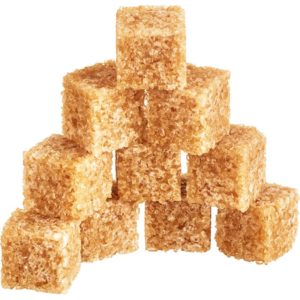
Ways to recognize a quality product:
- Add a little iodine to the sweetened water. If the liquid turns blue, then the tested product is real.
- Dissolve sugar in water. If it turns brownish, then it is a fake.
The harm of cane sugar and contraindications
In some cases, cane sugar can be harmful as well as health benefits. This is due to the relatively high calorie content. Consuming sweets in large quantities increases the risk of diseases such as diabetes, cancer and atherosclerosis, as well as diseases of the pancreas, which cannot process as much. In addition, sweets cause tooth decay.
Conclusion
The benefits and harms of cane sugar are determined by its composition and beneficial properties. It has a high content of useful elements. It is no coincidence that all over the world cane sugar is considered an elite environmentally friendly product. But if used uncontrolled, like any other sweetener, it can cause serious harm to health, especially when it comes to counterfeiting. It is important to learn how to monitor the dosage or use natural substitutes.

